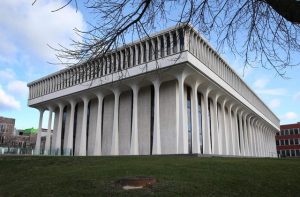The Smithsonian has acquired a collection of 146 slave badges from between 1800 and 1865
Starting in the late 17th century, enslavers in Charleston, South Carolina, began hiring out their enslaved laborers to earn some extra money. From 1783 onward, they were required to register these workers with the city and pay a fee. In return, they received badges listing various occupations, such as servant, carpenter, porter or mechanic. Enslaved individuals sewed the badges onto their clothing and were required to wear them at all times.
Many of these badges have been lost to history. But one collector, Harry S. Hutchins Jr., spent his life gathering as many as he could find.
Now, the Smithsonian’s National Museum of African American History and Culture (NMAAHC) has acquired Hutchins’ collection, which includes 146 slave badges from between 1800 and 1865.
The acquisition is thought to be the largest and most complete collection of Charleston slave badges, according to a statement from the museum. It also includes the only two known badges that identify a specific individual: a mechanic named Robert Cheevers.
The museum, which has launched a new digital tool featuring the badges, plans to use them to “honor the legacies of the men and women who endured slavery.”
Today, the slave badges serve as a reminder that enslaved laborers were responsible for building much of Charleston. They also highlight these individuals’ intellect, skills and abilities.
“It is a story that involves the juxtaposition of profit and power versus the human cost,” says Mary Elliott, a curator at NMAAHC, in the statement. “The story sheds light on human suffering and the power of the human spirit of skilled craftspeople who held onto their humanity and survived the system of slavery, leaving their mark on the landscape in more ways than one.”
/https://tf-cmsv2-smithsonianmag-media.s3.amazonaws.com/filer_public/7c/92/7c9285df-bae8-41b1-8736-8ffbf6a48bc8/nmaahc_slave_hire_badges.jpg)
Charleston instituted its slave badge system with an act that read: “No owner or other persons having the care and government of negroes or other slaves, shall permit any such slave, to be employed on hire, out of their respective houses or families without a ticket or badge first had and obtained from the Corporation of this City.”
“Slave badges are unique to Charleston—at least the metal ones are,” Grahame Long, a former senior curator for the Charleston Museum, told WCBD’s Brendan Clark in 2019. Similar systems existed in other cities, he added, “but Charleston is the only city to issue metal identification badges for these hired-out slave workers.”
Enslavers were required to re-register every year. When enslaved individuals ran away, their badge numbers were often referenced in newspaper ads offering rewards for their return.
The system was a form of control and surveillance, as well as a source of profit. Enslavers profited from the wages their laborers earned, while the city profited from the registration fees, taxes and fines for non-compliance. In addition, Charleston residents benefited from infrastructure built by enslaved workers, including paved roads and new buildings.
Those profits supplemented the money South Carolina made from the slave trade more broadly. At least 40 percent of enslaved individuals brought from Africa to colonial North America came through ports in South Carolina, which increased the colony’s wealth and power, per the museum.
“Looking at a slave badge evokes an emotional reaction,” James O. Horton, a former historian at George Washington University, told Smithsonian magazine’s Victoria Dawson in 2003. “There is the realization that one person actually owned another.”
In some cases, enslaved workers were allowed to keep the wages they earned for their labor, which they could save up to purchase their freedom. Being hired out also allowed them to “expand their networks and learn about efforts towards freedom,” according to the museum.
But even free Black men and women in South Carolina were under near-constant surveillance. They were also required to wear badges that identified them as such.
Occasionally, archaeologists unearth slave badges on former plantation sites and construction sites in Charleston. In 2021, for example, students and faculty at the College of Charleston discovered a slave badge from 1853.
These finds, as well as the recently acquired Hutchins collection, provide new insights into the city’s history.
“Though the individuals who wore them are no longer here, the Charleston slave badges bear witness to a community of laborers and artisans who held on to their humanity despite inhumane conditions,” according to the museum. “They left their mark as they created the historic Charleston landscape.”
Get the latest stories in your inbox every weekday.




